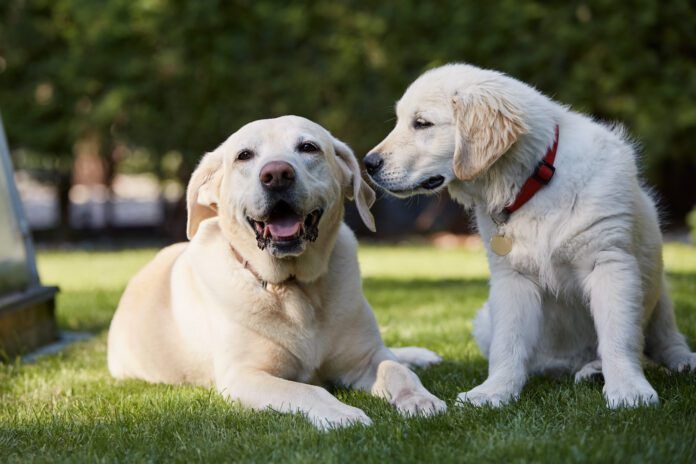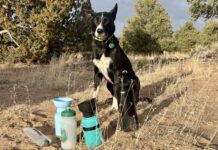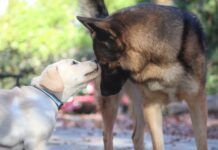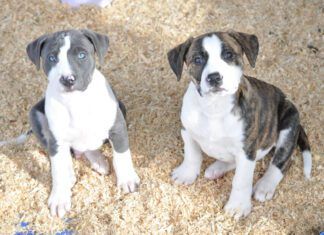It can be challenging to tell how old a rescue dog is, especially if not much is known about her history. However, there are some strategies that help narrow down a dog’s approximate age.
How to Tell How Old My Dog Is
When it comes to estimating how old a dog is, puppies are the easiest to age, because their bodies change in predictable ways on a monthly and even weekly basis. Adolescent dogs, usually recognizable by their lanky, slightly awkward appearance, are also fairly easy to guess ages for.
Adult and senior dogs are more difficult to determine age, both because there are fewer physical changes at these life stages and because different breeds and individual dogs can age at drastically different rates. For example, the average 10-year-old Chihuahua is in her prime, while the average 10-year-old Great Dane is geriatric.
Overall, there are five categories you can use to estimate your dog’s age: teeth, eyes, body condition, coat, and activity level.
How to Tell a Dog’s Age by Teeth
Here is a general timeline that most dogs’ teeth follow:
- Newborn puppies have no teeth.
- Sharp deciduous teeth (baby teeth) erupt between 2 and 8 weeks of age.
- Deciduous teeth start to fall out around 4 months old.
- By 6 or 7 months, all adult teeth are fully erupted and pearly white.
- 18 months to 2 years of age, the teeth start to show signs of wear and mild staining.
- Between 3 and 5 years, almost all dogs have some calculus buildup on the teeth.
- Between 5 and 10 years, teeth become more worn down.
- By 10 years of age, many dogs have significant calculus buildup and may show other signs of dental disease, including bad breath, gingivitis, and missing teeth.
Keep in mind that there are many things that can change how an individual dog’s teeth wear. Just like humans, some dogs are prone to building up plaque and calculus while others naturally retain healthy teeth (for example, Chihuahuas and Dachshunds are notorious for having nasty teeth even at a young age). Dental care such as feeding dental chews, brushing the teeth regularly with an enzymatic toothpaste, and periodic dental cleanings by a veterinarian will slow the progression of dental disease and give teeth a new lease on life.
Chronic chewers who like to gnaw on tennis balls, bones, rocks, or fences will wear their teeth down significantly faster than dogs who don’t do these things, and are also more likely to have broken and missing teeth.
How to Tell a Dog’s Age by Eyes
Very young puppies typically have a bluish cast to their irises which fades as they get older and their eyes turn to their adult color (usually a shade of brown, but sometimes true blue or other hues).
Young adult dogs will usually have clear, bright eyes and excellent vision both in bright light and in the dark.
Age-related changes to dogs’ eyes typically start around 7 years of age, but this can vary widely. Most dogs will develop changes in the lenses of the eyes which give the pupils a slightly hazy or cloudy appearance. This is called lenticular sclerosis, and will get more pronounced with age. Thankfully it does not significantly impact the dog’s vision.
Many senior dogs will start to show poorer vision at night and in poorly lit areas around 10-12 years old. This can be due to general aging changes in the eyes or due to a problem with the eyes.
While cataracts are most common in older dogs, they aren’t a great tool for determining how old a dog is since they can appear at any age. Juvenile cataracts are a hereditary disorder that causes puppies to develop cataracts. Most genetic cataracts show up later in life. Cataracts can also form after an injury of the eye or secondary to diabetes. Cataracts do impair vision, and can eventually cause complete blindness in one or both eyes. Small cataracts require a veterinarian or veterinary ophthalmologist to diagnose, but advanced cataracts will be clearly visible to the naked eye as white discs in the pupil.
How to Tell a Dog’s Age by Body Condition
Puppies under six months of age are typically very loosey-goosey and uncoordinated. If you look at an x-ray of these guys, there are huge gaps between their bones. These fill in over time as your puppy grows and produces more bone.
Adolescent dogs are more coordinated and have better stamina, but still typically have a lanky appearance. They are starting to develop muscles on the neck, chest, shoulders, and thighs, but mostly seem to grow longer and taller.
Growth plates can also help estimate how old a younger dog is. These typically close between 12 and 24 months of age depending on your dog’s breed(s) and size. Most medium-sized dogs will be fully grown at around 18 months of age, while toy breeds are closer to 12 months and giant breeds closer to 24 months. Your veterinarian can see on x-rays if your puppy’s growth plates have closed or if they are still open, indicating that she still has growing to do.
Adult dogs aged 2-8 years typically have good to excellent muscle tone and don’t change much physically unless ill or injured.
As a dog tips into being a senior between 8-12 years of age, she will gradually show muscle loss. This can become pronounced over time. The timing of these changes will depend on your dog’s breed, size, and how well her body was treated through life.
How to Tell a Dog’s Age by Coat
Puppies under 10 months of age usually have a soft, cottony puppy coat. Most breeds do a dramatic shed and coat change from 9-12 months where they start to grow in their adult coat (this is more pronounced in dogs with long or double coats).
Adolescents and young adults may have a rangier appearance, with their full adult coat coming in by 3 or 4 years of age. A healthy adult coat should be bright and vibrant, with texture varying by breed or mix.
Senior dogs often have a duller, more brittle coat.
Greying of the muzzle, head, and paws is another indication of age. However, some breeds, genetic lines, and even individual dogs will grey faster or slower than others. My dog who lived to almost 17 had barely any grey at all on her black face!
How to Tell a Dog’s Age by Activity Level
Puppies under about 8 months old typically play hard and then nap hard while adolescent dogs (7-24 months) are high energy, always wanting to play or do something new. They also can be very creative about entertaining themselves when bored.
The energy level of adult dogs will vary depending on your dog’s breed(s) and personality. In general, adult dogs are willing and able to engage in long walks or other activities with their people but can also settle for a rainy day on the couch. As a dog becomes a senior between 8 and 12 years of age, she will start to tire more easily and sleep more.
Genetic Age
If you are really curious about how old your rescue dog is, you can submit a genetic test!
Embark offers a Dog Age Test that uses a cheek swab to determine your dog’s approximate age and birthday. This test looks at the methylation of your dog’s DNA. Methylation is an epigenetic marker that changes predictably over time, allowing us to get a ballpark idea of when a dog was born.
There are also blood tests that measure the length of the telomeres on your dog’s chromosomes to determine approximate age. Telomeres are protective caps that get shorter as your dog ages.
None of these tests are exact, because individuals age at different rates based on their genetics, lifestyle, and life experiences. But they can be a fun way to get an idea of how old your dog is, especially if you are a science nerd!






